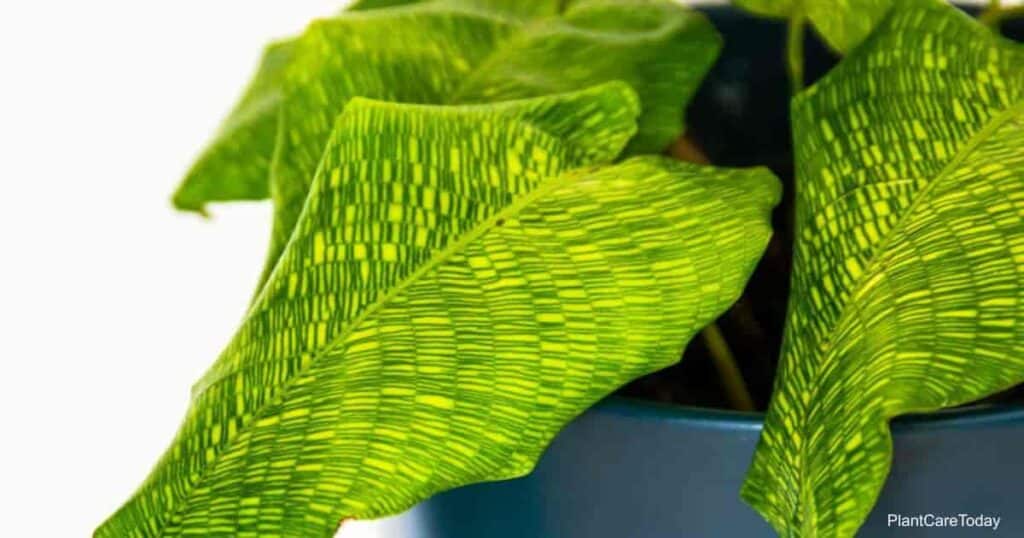The Calathea [kăl′ə-thē′ə] musaica is an ornamental, perennial houseplant favored for its attractive mosaic patterns. You may also hear people calling this plant by other names. Common nicknames include:
- Network
- Network Prayer plant
- Maranta Bella (original name)
- Goeppertia Bella
- Calathea Bella
- Goeppertia kegeljanii ‘Network’

The musaica is one of 300 species of Calathea, which belongs to the Marantaceae family. This category of arrowroot plants consists of 530 flower species from 31 genera.
Calathea musaica plants are native to South and Central America. They are predominant in tropical parts of Brazil and other rainforest climates.
Calathea Musaica Care
Compared to other Calathea species, the musaica is not as sensitive about its care. They are great beginner indoor plants if you want to test your plant care skills.
Size & Growth
Musaica plants grow from rhizomes. They have a slow growth rate and reach 2” tall and 2” – 3” wide at maturity.
When you care for your Calathea musaica plants correctly, you can enjoy their beauty for years. Improper care can shorten their lifespan.
The musaica has a more understated appearance than other Calathea species with slightly arching mid-green, glossy leaves.
A trademark feature of Calathea plants is their brightly striped leaves. The musaica features mosaic (crisscross) patterns rather than straight streaks.
During the day, the leaves change position so they can capture the most sunlight. At night, they fold down as if in prayer.
These traits are signature behaviors of all Calathea species, of which there are more than 300.
Flowering & Fragrance
When grown outdoors in their natural habitat, musaica plants produce small white flowers. But, it’s almost impossible to get these plants to flower when grown indoors.
The intricate mosaic pattern of the non-fragrant oval leaves provides a beautiful sight so you won’t miss the flowers.
Light & Temperature
Calathea musaica does best with warm indoor temperatures between 65° – 85° degrees Fahrenheit (18°F- 30°C) and free of wind drafts.
Temperatures below 60° degrees Fahrenheit (15°C) can cause the plant to stop growing. Currents of hot or cold air can cause the leaves to wilt or turn brown.
As a tropical species, these plants do well with medium to high humidity levels. The room needs at least 50% percent, although 60% – 80% percent is better.
Place a humidifier in the room to keep the air wet and humid. Misting your plants with water can also help increase humidity.
These plants do best with bright but indirect light. Early morning or late afternoon direct sunlight is usually not enough to harm your plants.
But avoid times when the sunlight is at its brightest, as the rays can cause the leaves to scorch or bleach out.
Many people move their Calathea musaica based on the seasons. In winter, these plants do best in north-east facing windows. Windows facing south will have the harshest light, so keep your plants at least 1′ – 10′ feet away.
Watering & Feeding
Because Calathea musaica prefers tropical conditions, these plants like to stay moist, but not soaked.
Rather than water on a schedule, water as needed. Check the soil every few days and water once the first inch of soil feels dry.
Soak the dirt entirely and allow the water to drain from the holes at the bottom of the pot. These plants need adequate drainage to prevent root rot.
Likewise, soil that’s too dry can cause the leaves to wilt.
Calatheas plants are susceptible to chemicals in the water. Avoid using unfiltered tap water from your faucet.
Distilled water works best, but filtered water or rainwater works too. If the leaf tips or edges are turning brown, switch water.
Read this article on Calathea Watering and its importance.
Musaica plants enjoy routine fertilization in the warm growing seasons of spring to summer. These plants only need a few drops once a month.
Never fertilize on dry soil; thoroughly saturate the dirt first.
Small plants only need fertilizing twice a year, using a diluted fertilizer. Full concentration can harm young plants.
Related: Care For Calathea Beauty Star Plant
Soil & Transplanting
Musaica plants needs a well-draining soil that retains moisture. NO soggy soil!
Regular houseplant potting mixes work, but most experts recommend adding amendments for better drainage. Some suggestions are gravel, coarse sand, or perlite.
Another option is to use peat moss instead, with a two-to-one ratio of peat to perlite. You can also substitute coco coir for peat or use one part of all three. Always use a pot or container with a drainage hole and fresh soil.
The pH of the soil can also affect musaica growth. Calatheas do best in soil pHs between 6 (neutral) and 7.5 (acidic).
Musaica plants need transplanting or repotting every two to three years to prevent becoming rootbound.
Grooming & Maintenance
It’s best to get into the habit of grooming your plants a few times a week. Use a clean damp cloth to wipe off the leaves to remove any dirt or dust.
Calathea Musaica does not need regular pruning, although you should remove any dead foliage or brown leaf tips. You may also choose to prune any damaged leaves by cutting the leaves right above the soil level.
How To Propagate Calathea Musaica
Musaica plants propagate by rhizomes or root division. When you repot your plant in spring, divide the plant at the roots and transplant the pieces into separate pots.
Use care so you do not damage the roots, which can affect growth.
Related: Propagation of Calathea plants.
Calathea Musaica Pests Or Diseases
You’ll have to be on the lookout for many types of pests that feed on Calathea plants. These include fungus gnats, mealybugs, spider mites, scale, and thrips.
Disease-wise, the musaica is a hardy species of house plants that is not prone to any particular diseases. Ensuring you provide proper watering and ventilation should keep diseases away.
